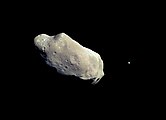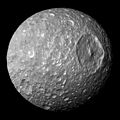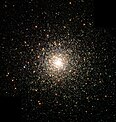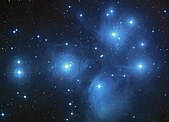Heavenly body
|
|||||||
| Selection of astronomical bodies and objects |
An astronomical object or celestial object is a naturally occurring physical entity, association, or structure that current astronomy has demonstrated to exist in the observable universe.
In astronomy, the terms "object" and "body" are often used interchangeably. However, an astronomical body or celestial body refers to a single, tightly bound contiguous entity, while an astronomical or celestial object refers to a complex, less cohesively bound structure, that may consist of multiple bodies or even other objects with substructures.
Examples for astronomical objects include planetary systems, star clusters, nebulae and galaxies, while asteroids, moons, planets, and stars are astronomical bodies. A comet may be identified as both body and object: It is a body when referring to the frozen nucleus of ice and dust, and an object when describing the entire comet with its diffuse coma and tail.
The universe can be viewed as having a hierarchical structure. At the largest scales, the fundamental component of assembly is the galaxy. Galaxies are organized into groups and clusters, often within larger superclusters, that are strung along great filaments between nearly empty voids, forming a web that spans the observable universe.
Galaxies have a variety of morphologies, with irregular, elliptical and disk-like shapes, depending on their formation and evolutionary histories, including interaction with other galaxies, which may lead to a merger. Disc galaxies encompass lenticular and spiral galaxies with features, such as spiral arms and a distinct halo. At the core, most galaxies have a supermassive black hole, which may result in an active galactic nucleus. Galaxies can also have satellites in the form of dwarf galaxies and globular clusters.
...
Wikipedia















